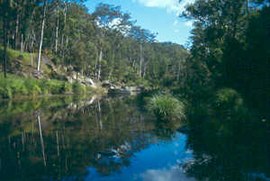Carnarvon National Park
|
Carnarvon National Park Queensland |
|
|---|---|
|
IUCN category II (national park)
|
|

Carnarvon Creek and Gorge
|
|
| Nearest town or city | |
| Coordinates | 24°38′09″S 147°59′50″E / 24.63583°S 147.99722°ECoordinates: 24°38′09″S 147°59′50″E / 24.63583°S 147.99722°E |
| Established | 28 April 1932 |
| Area | 2,980 km2 (1,150.6 sq mi) |
| Visitation | Approx. 65,000 |
| Managing authorities | Queensland Parks and Wildlife Service |
| Website | Carnarvon National Park |
| See also | Protected areas of Queensland |
Carnarvon National Park is located in the Southern Brigalow Belt bioregion in Central Queensland (Australia), 593 km northwest of Brisbane. It began life as a 26,304-hectare reserve gazetted in 1932 to protect Carnarvon Gorge for its outstanding scenic values, its indigenous and non-indigenous cultural heritage, and its geological significance.
Situated within the Central Queensland Sandstone Belt, and straddling the Great Dividing Range, Carnarvon National Park preserves and presents significant elements of Queensland's geological history including two sedimentary basins, the Bowen and the Surat, and the Buckland Volcanic Province. The youngest rocks in the area are the igneous basalt rocks of the Buckland volcanic Province, which were laid down between 35 and 27 million years ago. Since that time, water and wind have eroded the park's landscapes into a network of sandy plains, valleys, and gorges separated by basalt-capped tablelands and ranges.
The park is rich in groundwater, numerous springs. The elevated areas protected within Carnarvon National Park have high value for above-ground catchments as well. Five major river systems rise within the park's boundary: the Comet, Dawson, Maranoa, Nogoa, and Warrego. The Warrego and Maranoa lie inland of the Great Dividing Range on the northern boundary of the Murray-Darling Basin.
Forty regional ecosystems are known to exist within the park and nine of them are listed as endangered, due to large-scale land clearing within the region. Twenty-three species of flora listed as rare and threatened (Under Queensland legislation) have been found in the park, including the iconic Livistona nitida (Carnarvon Fan Palm, Carnarvon Gorge section), Cadellia pentastylis (Ooline, Moolayember section), and Stemmacantha australis (Austral Cornflower, Mount Moffatt section).
...
Wikipedia

